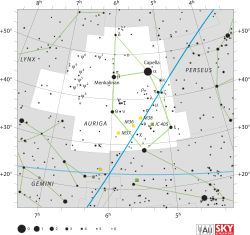HD 34078
| HD 34078 | |
 | |
| Observationsdata Epok: J2000.0 | |
|---|---|
| Stjärnbild | Kusken |
| Rektascension | 05t 16m 18,15000s[1] |
| Deklination | +34° 18′ 44,3455″[1] |
| Skenbar magnitud () | +5,96 (V)[2], (5,78 - 6,08[3]) |
| Stjärntyp | |
| Spektraltyp | O9.5 V[4] |
| U–B | -0,70[2] |
| B–V | +0,22[2] |
| Astrometri | |
| Radialhastighet () | 56,70 ± 0,6[5] km/s |
| Egenrörelse (µ) | RA: -4,440[6] mas/år Dek.: 43,368[6] mas/år |
| Parallax () | 2,4642 ± 0,0660[6] |
| Avstånd | 1 320 ± 40 lå (410 ± 10 pc) |
| Absolut magnitud () | -2,81[7] |
| Detaljer | |
| Massa | 23[8] M☉ |
| Radie | 7,47[8] R☉ |
| Luminositet | 59 000[8] L☉ |
| Temperatur | 33 000[8] K |
| Vinkelhastighet | 25[8] km/s |
| Andra beteckningar | |
| HD 34078, AG+34 542, ALS 8255, BD+34 980, CCDM J05163+3419A, CEL 587, GSC 02398-00894, HIC 24575, HIP 24575, HR 1712, IRAS 05130+3415, LS V +34 3, 2MASS J05161814+3418443, PLX 1190, PPM 70112, SAO 57816, TD1 4252, TYC 2398-894-1, uvby98 100034078, ABV V*, AE Aur, VDB 34, WDS J05163+3419AB, Gaia DR1 182071566417283328, Gaia DR2 182071570715713024 [9] | |
HD 34078 är en ensam stjärna belägen i den södra delen av stjärnbilden Kusken. Den har en genomsnittlig skenbar magnitud av ca 5,96[2] och är mycket svagt synlig för blotta ögat där ljusföroreningar ej förekommer. Baserat på parallax enligt Gaia Data Release 2 på ca 2,5[6] mas, beräknas den befinna sig på ett avstånd på ca 1 320 ljusår (ca 410 parsek) från solen. Den rör sig bort från solen med en heliocentrisk radialhastighet på ca 57 km/s.[5]
Egenskaper[redigera | redigera wikitext]
HD 33463 är en blå stjärna i huvudserien av spektraltyp O9.5 V.[4] Den har en massa som är ca 23[8] solmassor, en radie som är ca 7,5[8] solradier och har ca 59 000 gånger solens utstrålning av energi[8] från dess fotosfär vid en effektiv temperatur av ca 33 000 K.[8]

HD 34078 klassificeras som en variabel stjärna av Oriontyp. Den är en flyktstjärna som kan ha kastats ut under en kollision mellan två dubbelstjärnor. Denna kollision, som också tillskrivs att ha stött ut Mu Columbae och eventuellt 53 Arietis, har spårats till Trapeziumhopen i Orionnebulosan för två miljoner år sedan. Dubbelstjärnan Jota Orionis kan ha varit den andra hälften av denna kollision.[10]
HD 34078 anses tända upp Flaming Star-nebulosan, men den bildades inte i denna. Istället passerar den genom nebulosan med hög hastighet och genererar en kraftig chockvåg och elektromagnetisk strålning med hög energi.[11][12]
Se även[redigera | redigera wikitext]
Referenser[redigera | redigera wikitext]
- Den här artikeln är helt eller delvis baserad på material från engelskspråkiga Wikipedia, AE Aurigae, 15 augusti 2020.
Noter[redigera | redigera wikitext]
- ^ [a b] Van Leeuwen, F. (2007). "Validation of the new Hipparcos reduction". Astronomy and Astrophysics. 474 (2): 653. arXiv:0708.1752. Bibcode:2007A&A...474..653V. doi:10.1051/0004-6361:20078357.
- ^ [a b c d] Ducati, J. R. (2002). "VizieR Online Data Catalog: Catalogue of Stellar Photometry in Johnson's 11-color system". CDS/ADC Collection of Electronic Catalogues. 2237. Bibcode:2002yCat.2237....0D.
- ^ Samus, N. N.; Durlevich, O. V.; et al. (2009). "VizieR Online Data Catalog: General Catalogue of Variable Stars (Samus+ 2007-2013)". VizieR On-line Data Catalog: B/gcvs. Originally Published in: 2009yCat....102025S. 1. Bibcode:2009yCat....102025S.
- ^ [a b] Sota, A.; Maíz Apellániz, J.; Walborn, N. R.; Alfaro, E. J.; Barbá, R. H.; Morrell, N. I.; Gamen, R. C.; Arias, J. I. (2011). "The Galactic O-Star Spectroscopic Survey. I. Classification System and Bright Northern Stars in the Blue-violet at R ~ 2500". The Astrophysical Journal Supplement. 193 (2): 24. arXiv:1101.4002. Bibcode:2011ApJS..193...24S. doi:10.1088/0067-0049/193/2/24.
- ^ [a b] Kharchenko, N. V.; Scholz, R.-D.; Piskunov, A. E.; Röser, S.; Schilbach, E. (2007). "Astrophysical supplements to the ASCC-2.5: Ia. Radial velocities of ˜55000 stars and mean radial velocities of 516 Galactic open clusters and associations". Astronomische Nachrichten. 328 (9): 889. arXiv:0705.0878. Bibcode:2007AN....328..889K. doi:10.1002/asna.200710776.
- ^ [a b c d] Brown, A. G. A.; et al. (Gaia collaboration) (August 2018). "Gaia Data Release 2: Summary of the contents and survey properties". Astronomy & Astrophysics. 616. A1. arXiv:1804.09365. Bibcode:2018A&A...616A...1G. doi:10.1051/0004-6361/201833051.
- ^ https://www.universeguide.com/star/24575/aeaurigae. Hämtad 2020-08-14.
- ^ [a b c d e f g h i] Martins, F.; Hervé, A.; Bouret, J.-C.; Marcolino, W.; Wade, G. A.; Neiner, C.; Alecian, E.; Grunhut, J.; Petit, V. (2015). "The MiMeS survey of magnetism in massive stars: CNO surface abundances of Galactic O stars". Astronomy & Astrophysics. 575: A34. arXiv:1411.4420. Bibcode:2015A&A...575A..34M. doi:10.1051/0004-6361/201425173.
- ^ http://simbad.u-strasbg.fr/simbad/sim-id?Ident=HD+34078. Hämtad 2020-08-15.
- ^ Hoogerwerf, R.; De Bruijne, J. H. J.; De Zeeuw, P. T. (2001). "On the origin of the O and B-type stars with high velocities. II. Runaway stars and pulsars ejected from the nearby young stellar groups". Astronomy and Astrophysics. 365 (2): 49. arXiv:astro-ph/0010057. Bibcode:2001A&A...365...49H. doi:10.1051/0004-6361:20000014.
- ^ López-Santiago, J.; Miceli, M.; Del Valle, M. V.; Romero, G. E.; Bonito, R.; Albacete-Colombo, J. F.; Pereira, V.; De Castro, E.; Damiani, F. (2012). "AE Aurigae: First Detection of Non-thermal X-Ray Emission from a Bow Shock Produced by a Runaway Star". The Astrophysical Journal Letters. 757: L6. arXiv:1208.6511. Bibcode:2012ApJ...757L...6L. doi:10.1088/2041-8205/757/1/L6.
- ^ France, Kevin; McCandliss, Stephan R.; Lupu, Roxana E. (2007). "A Cometary Bow Shock and Mid-Infrared Emission Variations Revealed in Spitzer Observations of HD 34078 and IC 405". The Astrophysical Journal. 655 (2): 920. arXiv:astro-ph/0610953. Bibcode:2007ApJ...655..920F. doi:10.1086/510481.
Externa länkar[redigera | redigera wikitext]
- https://www.universeguide.com/star/24575/aeaurigae.
- http://stars.astro.illinois.edu/sow/aeaur.html
- AE Aur VizieR GCVS entry
- HR 1712 VizieR Bright star catalogue entry





